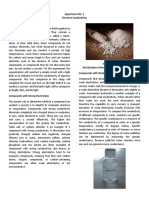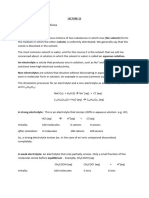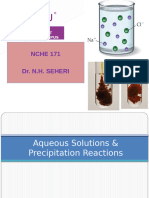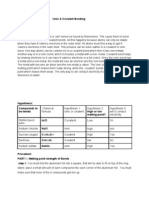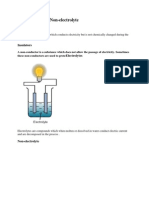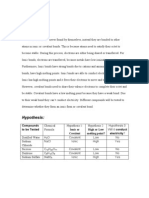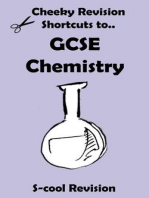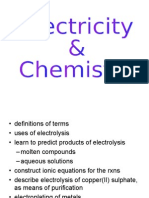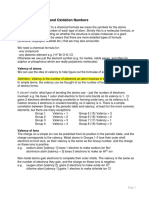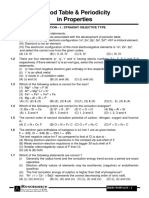0 ratings0% found this document useful (0 votes)
53 viewsElectrolyte and Redox: Chemistry Report
Electrolyte and Redox: Chemistry Report
Uploaded by
Grace KahonoThis chemistry report summarizes an experiment on electrolytes and redox reactions. The experiment tested various strong electrolytes, weak electrolytes, and non-electrolytes by observing their ability to light a bulb and produce bubbles when added to water. Strong electrolytes like HCl and NaCl conducted electricity well by lighting the bulb brightly and producing many bubbles. Weak electrolytes like acetic acid conducted electricity poorly by only producing a few bubbles but no light. Non-electrolytes like sugar did not conduct electricity at all. The report also discusses a redox reaction where copper(II) oxide and carbon were heated together, resulting in a color change as copper was formed.
Copyright:
© All Rights Reserved
Available Formats
Download as DOCX, PDF, TXT or read online from Scribd
Electrolyte and Redox: Chemistry Report
Electrolyte and Redox: Chemistry Report
Uploaded by
Grace Kahono0 ratings0% found this document useful (0 votes)
53 views7 pagesThis chemistry report summarizes an experiment on electrolytes and redox reactions. The experiment tested various strong electrolytes, weak electrolytes, and non-electrolytes by observing their ability to light a bulb and produce bubbles when added to water. Strong electrolytes like HCl and NaCl conducted electricity well by lighting the bulb brightly and producing many bubbles. Weak electrolytes like acetic acid conducted electricity poorly by only producing a few bubbles but no light. Non-electrolytes like sugar did not conduct electricity at all. The report also discusses a redox reaction where copper(II) oxide and carbon were heated together, resulting in a color change as copper was formed.
Original Description:
dskjndksf
Original Title
Chemistry Report Final
Copyright
© © All Rights Reserved
Available Formats
DOCX, PDF, TXT or read online from Scribd
Share this document
Did you find this document useful?
Is this content inappropriate?
This chemistry report summarizes an experiment on electrolytes and redox reactions. The experiment tested various strong electrolytes, weak electrolytes, and non-electrolytes by observing their ability to light a bulb and produce bubbles when added to water. Strong electrolytes like HCl and NaCl conducted electricity well by lighting the bulb brightly and producing many bubbles. Weak electrolytes like acetic acid conducted electricity poorly by only producing a few bubbles but no light. Non-electrolytes like sugar did not conduct electricity at all. The report also discusses a redox reaction where copper(II) oxide and carbon were heated together, resulting in a color change as copper was formed.
Copyright:
© All Rights Reserved
Available Formats
Download as DOCX, PDF, TXT or read online from Scribd
Download as docx, pdf, or txt
0 ratings0% found this document useful (0 votes)
53 views7 pagesElectrolyte and Redox: Chemistry Report
Electrolyte and Redox: Chemistry Report
Uploaded by
Grace KahonoThis chemistry report summarizes an experiment on electrolytes and redox reactions. The experiment tested various strong electrolytes, weak electrolytes, and non-electrolytes by observing their ability to light a bulb and produce bubbles when added to water. Strong electrolytes like HCl and NaCl conducted electricity well by lighting the bulb brightly and producing many bubbles. Weak electrolytes like acetic acid conducted electricity poorly by only producing a few bubbles but no light. Non-electrolytes like sugar did not conduct electricity at all. The report also discusses a redox reaction where copper(II) oxide and carbon were heated together, resulting in a color change as copper was formed.
Copyright:
© All Rights Reserved
Available Formats
Download as DOCX, PDF, TXT or read online from Scribd
Download as docx, pdf, or txt
You are on page 1of 7
CHEMISTRY REPORT
ELECTROLYTE AND REDOX
Disusun Oleh :
Angela Lois X3/05
Annabella Sulianto X3/06
Jonathan Hirawan X3/18
Priscilla Viera X3/28
SMA Santa Laurensia
2012
ELECTROLYTE SOLUTION
A. Strong Electrolytes
Results
Solution
Phenomenons
Light Bubbles
HCl solution v (bright) v (many)
H
2
SO
4
solution v (less brighter than HCl) v (many)
NaOH solution x v (many)
Ba(OH)
2
solution x v (few)
NaCl solution v (dim) v (many)
Notes x = not existed (theres no light/ bubble) v = existed (theres light or bubble)
Analysis
HCl , H
2
SO
4
, NaOH, Ba(OH)
2
, and NaCl are strong electrolytes. HCl and
H
2
SO
4
are inorganic acids, while NaOH and Ba(OH)
2
are inorganic bases. Four of
them are strong electrolytes because they are polar covalent compound that undergo
complete ionization. Meanwhile, NaCl is a salt or an ionic compound, thus it will
undergo complete dissociation when dissolved in water.
1. HCl solution undergoes complete ionization in its solvent (water). Thus, it can
conduct electricity as proven in the experiment, the solution of HCl could light
a bulb brightly and produce many bubbles, which means it is a good electrical
conductor.
2. H
2
SO
4
solution also undergoes complete ionization in its solvent (water). Thus
it can light a bulb brightly (less brighter than HCl) and produce many bubbles,
which means it also a good electrical conductor.
3. NaOH solution undergoes complete dissociation in its solvent (water), but it
cant light a bulb and only produce bubbles. Which means t is a poor
electrical conductor.
4. Ba(OH)
2
solution undergoes complete dissociation in its solvent (water), but
similar as NaOH it cant light a bulb and only produce few bubbles. Which
means it is a poor electrical conductor.
5. NaCl solution undergoes complete dissociation in its solvent (water), it can
light a bulb even though dimly, and produce many bubble, which means it is a
good electrical conductor, but not as good as HCl and H
2
SO
4
.
Discussion
Generally, a strong electrolyte such as those five solutions could light a bulb
brightly and produce many bubbles, as they are a good electrical conductor. It
happened because when the substance dissolved in water, (water is a polar covalent
compound that dissolved polar substance such as ionic and another polar covalent
compound) they will be surrounded by water molecules (H
2
O). Water molecules that
have partial (+) and (-) charge will attract opposite charge of the dissolved substance.
The partial (+) charge of water molecules will attract the (-) charge of the dissolved
substance, and the partial (-) charge of water molecules will attract the (+) charge of
the dissolved substance. If the attraction force (intermolecular force) between the
water molecules and substance is strong enough, it will break the covalent bond of the
substance and form many free ions. The formation of free ions will allow current to
pass, thus the solution can conduct electricity.
Despite the fact of the theory above, the experiment gives a different result. Not
all of the strong electrolyte can be good electrical conductor, such as Ba(OH)
2
and
NaOH. What matters is the solubility of the substance in its solvent (water), those
substance have various solubility in water. The bigger the solubility of a substance in
its solvent, more particles will dissolved in the solvent and more free ions will formed.
More free ions in a solution means the solution will allow more current to pass
through it, and be a good electrical conductor. On the other hand, the lower the
solubility of a substance in its solvent, less particles will dissolved in the solvent and
less free ions will formed. Less free ions in a solution means the solution will allow
less current to pass through it, and be a poor electrical conductor. In this case, HCl,
H
2
SO
4
, and NaCl have a bigger solubility so they are a good electrical condutor,
meandwhile Ba(OH)
2
and NaOH have a low solubilty so they are a poor electrical
conductor.
Conclusion
A strong electrolyte is not always a good electrical conductor; it depends on the
solubility of the substance in its solvent.
B. Weak Electrolytes
Results
Solution
Phenomenons
Light Bubbles
CH
3
COOH solution x v (few)
Citric acid solution
(C
6
O
8
H
7
)
x v (few)
Ammonia solution
(NH
3
)
x v (few)
Analysis
CH
3
COOH solution and Citric acid solution (C
6
O
8
H
7
) are weak electrolytes. Both of
them are organic acid, while NH
3
is organic base, which also classified as weak
electrolytes. They can conduct electricity although they are not ionic compounds
because they are polar covalent compounds that have partial positive charge and
partial negative charge that undergo partial ionization when it is dissolved in water.
1. CH
3
COOH solution undergoes a partial ionization, when dissolved in its
solvent (water). It cant conduct electricity, but produce a few bubbles. From
the result above we can state that CH
3
COOH is a poor electrical conductor.
2. Citric acid solution (C
6
O
8
H
7
) also undergoes a partial ionization in its solvent
(water). It cant conduct electricity but only produce a few bubbles. From the
result we can conclude that it is a poor electrical conductor.
3. Ammonia solution (NH
3
) also undergoes a partial ionization when it is
dissolved in its solvent (water). It cant light the bulb and produces few
bubbles, so it is a poor electrical conductor.
Discussion
Generally, a weak electrolyte such as those two solutions can conduct
electricity but an only produce a dim light and bubbles because they are a poor
electrical conductor. This happens because they are a polar covalent compound that
has partial negative charge and partial positive charge that makes them undergo a
partial ionization. When it is dissolved in the water, the positive charge in the water
molecule will attract the negative charge of the substance and the negative charge of
the water will attract the positive charge of the substance, because the polar covalent
compound only have a partial negative charge and partial positive charge, so the
attraction force (intermolecular force) between the substance and the water
(solvent) is not so strong, making only a few particles of the substance can separate
and forming only a few free ions that can conduct electricity thus they will conduct
electricity poorly by producing dim light and few bubbles.
Just like the first explanation from the strong electrolytes, not all of the weak
electrolytes will produce a dim light but most of them will only produce some bubbles.
From the result we can conclude that the three solutions CH
3
COOH solution, Citric
acid solution (C
6
O
8
H
7
), and Ammonia has a low solubility in its solvent (water), so
few particles dissolved and it will ionized partially. Thus will allow less current to
pass through it make them cant light a bulb, but only produce some bubbles. There
are no enough free ions to light the bulb.
Conclusion
Weak electrolytes do not always produce a dim light and bubbles; many of
those only produce bubbles without the light because the low solubility also affects
the presence of ions in the solvent.
C. Non-Electrolytes
Results
Solution
Phenomenons
Light Bubbles
Sugar solution x x
Alcohol x x
Analysis
Sugar solution and Alcohol are non-electrolytes. Both of them are organic compunds.
They cant conduct electricity, but actually they are polar covalent compounds that
have partial positive charge and partial negative charge and can dissolve in water.
Although they dissolve in water, but they dont undergo ionization, or not ionized.
1. Sugar solution can dissolve in water because it is polar covalent compound,
even though sugar dissolves in water, it is not ionized so the solution cant
conduct electricity.
2. Alcohol also a polar covalent compound, alcohol dissolve in water, but even
though alcohol dissolve in water they didnt undergo ionization, so they cant
conduct electricity.
Discussion
Non-electrolyte such as those two solutions cant conduct electricity and they
didnt produce any light or bubbles because they are non-electrical conductors even
though they organic compound and can dissolve in water. This happens because they
are polar covalent compound that have partial positive charge and partial negative
charge, but when they dissolve in water, the attraction force (intermolecular force)
between water molecules and substance is very weak, so it cant break particles of
the substance into free ions, hence no ions are formed. These solutions are not ionized
because no free ions are formed that eventually makes it dont produce any light or
bubbles. If no free ions are formed, so there will be no charge to pass, thus the
solution wont conduct electricity.
Conclusion
Non-electrolytes always produce no light and no bubbles in solution or molten
form; because they didnt undergo ionization even though they are soluble in water.
REDOX REACTION
Results
One spatule of copper(II) oxide as black powder mixed with one spatule of
carbon powder. They were reacted by heating with spiritus burner and produced
brown copper in solid state. Beside solid copper, carbon monoxide also produced as
the result of the reaction. The formula of the reaction is :
CuO + C Cu + CO
Copper(II) oxide reacted with carbon, produced copper and carbon monoxide.
Analysis
The reaction between copper(II) oxide and carbon as black powder produced
copper solid with brown color and carbon monoxide as the result with formula of
CuO + C Cu + CO. This reaction included redox reaction base on oxygen because
there is gain and loss of oxygen and oxidation state because there is changing in
oxidation state. The most apparent of redox reaction is gain and loss of oxygen and
the changes of oxidation state. Copper(II) oxide loses its oxygen to become copper
and carbon gain oxygen to become carbon monoxide, so it is obviously redox reaction.
Beside that, there is changing of oxidation state because clearly there are free
elements, which are carbon that reacted and copper as the result of the reaction.
Discussion
There are 4 types of redox reaction, which are gain or loss oxygen, gain or loss
hydrogen, gain or loss electrons, and changes of oxidation state. The reaction between
copper(II) oxide and carbon is redox reaction that can be explained by oxygen and
oxidation state theory. It cant be explained by hydrogen theory because there is no
hydrogen included in the reaction, so there is no gain or loss hydrogen in it. It cant
also be explained by gain or loss electrons because element in each compound is
neutral and the charges are the same, thus there is no gain or loss electrons. In
conclusion, the reaction between copper(II) oxide and carbon that produce copper and
carbon monoxide is redox reaction base on theory of gain or loss oxygen and changes
of oxidation states. In redox reaction, there are oxidising agent, reduction agent,
oxidation result, and reduction result. Oxidising agent is substance that causes
oxidation while reducing agent is substance that causes reduction. Oxidation result is
the result of oxidation while reduction result is the result of reduction.
Base on oxygen theory, copper(II) oxide (CuO) loses oxygen to become
copper (Cu) solid, and carbon (C) gains oxygen to become carbon monoxide (CO).
Oxidation means the gain of oxygen and reduction means the loss of oxygen. This
means copper(II) oxide undergoes reduction because it loses oxygen to become
copper, while carbon undergoes oxidation because it gains oxygen to become carbon
monoxide. Copper(II) oxide acts as oxidising agent since it causes the oxidation of
carbon. On the other hand, carbon acts as reducing agent since it causes the reduction
of copper(II) oxide. As the result of the reaction, copper is reduction result, because
the copper(II) oxide is reduced and the carbon is oxidised, thus carbon monoxide is
oxidation result.
CuO + C Cu + CO
Beside on oxygen and electrons theory, this reaction can also be explained by
oxidation state because there are changing in oxidation states. Oxidation is increase in
oxidation state and reduction is decrease in oxidation state. Total sum of oxidation
numbers of the atoms in neutral compound is 0. The oxidation number of oxygen is -2
in most compounds, except in fluoride, which is +2, peroxide which is -1, and
superoxide which is -1/2. While the oxidation number of free element is 0. In both
copper(II) oxide and carbon monoxide, the oxidation state of oxygen is -2, thus it
does not undergo anything. Copper in copper(II) oxide has oxidation state of +2,
because the oxygen has oxidation state of -2 (to make it neutral) while copper solid
has oxidation state of 0 because it is free element, so copper undergoes reduction
because the oxidation state is decreased from +2 to 0. Carbon undergoes oxidation
because the oxidation state is increased from 0 in carbon to +2 in carbon monoxide.
Copper(II) oxide is oxidising agent that causes oxidation and carbon is reducing agent
that causes reduction while in the result, copper is reduction result because copper(II)
oxide has undergo reduction and carbon monoxide is oxidation result because carbon
has undergo oxidation.
+2 0 0 +2
CuO + C Cu + CO
Conclusion
In conclusion, redox reaction takes place in the reaction between copper(II)
oxide and carbon. The redox reaction can be explained by the gain or loss of oxygen
and the changes of oxidation state.
oxidising
agent
reducing
agent
reduction
result
oxidation
result
OXIDATION
oxidising
agent
reducing
agent
reduction
result
oxidation
result
OXIDATION
REDUCTION
REDUCTION
You might also like
- Science Curriculum by Aaron KellerDocument7 pagesScience Curriculum by Aaron KellerResta THawNo ratings yet
- MD-490M Manual PDFDocument70 pagesMD-490M Manual PDFjanethbm50% (2)
- Experiment 5 Dissimilarity Between Ionic and Covalent CompoundsDocument5 pagesExperiment 5 Dissimilarity Between Ionic and Covalent CompoundsNurasyilah YakubNo ratings yet
- EXPERIMENT 6 Dissimilarity Between LECTROVALENT AND COVALENT BONDDocument7 pagesEXPERIMENT 6 Dissimilarity Between LECTROVALENT AND COVALENT BONDMuhamad Faris88% (8)
- Chapter 4: Reactions in Aqueous SolutionsDocument11 pagesChapter 4: Reactions in Aqueous SolutionsMilinPatelNo ratings yet
- 5 - ConductivityDocument5 pages5 - ConductivitydhanielieneNo ratings yet
- Electrolyte and NonDocument7 pagesElectrolyte and NonSuwahono, M.PdNo ratings yet
- Chapter 4Document80 pagesChapter 4zoo.zooba99No ratings yet
- Electrochemistry For Materials Science - BELTOWSKA - 2 PDFDocument50 pagesElectrochemistry For Materials Science - BELTOWSKA - 2 PDFSumit ShankarNo ratings yet
- Bài 1- Tính chất của dung môi nướcDocument61 pagesBài 1- Tính chất của dung môi nướcdoannguyenNo ratings yet
- Advanced ChemistryDocument137 pagesAdvanced ChemistryMaheshNo ratings yet
- Electrical Conductivity Laboratory ReportDocument7 pagesElectrical Conductivity Laboratory ReportSteven Lee100% (1)
- Laboratory Activity 1Document13 pagesLaboratory Activity 1Ashley PapaNo ratings yet
- Electrolysis PDFDocument37 pagesElectrolysis PDFHarini SridharanNo ratings yet
- Final Results Table Ionic and Covalent Compound Conduction ExperimentDocument3 pagesFinal Results Table Ionic and Covalent Compound Conduction Experimentniya.sokolova2006No ratings yet
- Ions in Solution - Weak and Strong ElectrolytesDocument4 pagesIons in Solution - Weak and Strong Electrolytesjimmymungai018No ratings yet
- 215LabManual PhysProps Jan18Document5 pages215LabManual PhysProps Jan18bigcheeseNo ratings yet
- Experiment 5 LabrepDocument4 pagesExperiment 5 LabrepDI LacsonNo ratings yet
- ELECTROLYTES Mechanics AssignmentDocument4 pagesELECTROLYTES Mechanics Assignmentbighnesh.2006.singhNo ratings yet
- Lecture 12a ChemDocument7 pagesLecture 12a Chemlldgee33No ratings yet
- ChemDocument6 pagesChems13581No ratings yet
- Determining The Dissociation Products of ElectrolytesDocument3 pagesDetermining The Dissociation Products of Electrolytesnicole olivaNo ratings yet
- Lec 1. Electrolytes-1Document28 pagesLec 1. Electrolytes-1Falak SherNo ratings yet
- Chemistry - Chang 10th Edition 3Document1 pageChemistry - Chang 10th Edition 3Ayman MurrarNo ratings yet
- Chemical Bond (ContDocument18 pagesChemical Bond (ContJachinta JuliusNo ratings yet
- Ionic EquilibriumDocument93 pagesIonic EquilibriumhappyNo ratings yet
- Lesson 12 Aqueous Solutions - Precipitation ReactionsDocument32 pagesLesson 12 Aqueous Solutions - Precipitation Reactionsz9qv4vyjbjNo ratings yet
- Reviewer Finals - Anachem LecDocument7 pagesReviewer Finals - Anachem LecJayne DanielleNo ratings yet
- I. Experiment II. Starting of Experiment Iii. Finishing of Experiment IV. Purpose To Observe The Changing of Chlor Unsure inDocument8 pagesI. Experiment II. Starting of Experiment Iii. Finishing of Experiment IV. Purpose To Observe The Changing of Chlor Unsure inAinur RokhNo ratings yet
- Electrolysis Notes S4 GHSDocument37 pagesElectrolysis Notes S4 GHSMutonyi KimberlyNo ratings yet
- Lecture 2 - Lifes - Chemical - BasisDocument25 pagesLecture 2 - Lifes - Chemical - BasisPooja ChaudharyNo ratings yet
- Katia Medina Larkin 2Document3 pagesKatia Medina Larkin 2kmedina2014No ratings yet
- Reactions in Aqueous U4Document108 pagesReactions in Aqueous U4lieu.huynhkim0520No ratings yet
- Experiment 1 - Conductivity 141 v1Document9 pagesExperiment 1 - Conductivity 141 v1rodneyperuNo ratings yet
- Electrolysis 2022-23Document18 pagesElectrolysis 2022-23Yasha RizviNo ratings yet
- The Molecule of WaterDocument13 pagesThe Molecule of WaterAmalNo ratings yet
- Physical-Science-Module 5 Polarity and Intermolecular Forces of AttractionDocument45 pagesPhysical-Science-Module 5 Polarity and Intermolecular Forces of AttractionJoana Castillo100% (1)
- CH101 006 Final ProjectDocument3 pagesCH101 006 Final ProjectLeena VoNo ratings yet
- Nirav Sir: 2 + - (S) + (Aq) - (Aq)Document19 pagesNirav Sir: 2 + - (S) + (Aq) - (Aq)api-233404189No ratings yet
- Investigation of The Chemical and Physical Properties of Ionic and Covalent BondingDocument7 pagesInvestigation of The Chemical and Physical Properties of Ionic and Covalent Bondingapi-238781118100% (1)
- Obj:-Q) Can Anyone Answer How Many Halogens Are Der in PTDocument5 pagesObj:-Q) Can Anyone Answer How Many Halogens Are Der in PTSamia KhanNo ratings yet
- Electrolyte and Non Electrolyte SolutionDocument17 pagesElectrolyte and Non Electrolyte SolutionAnnieSyahidahNo ratings yet
- Electrolyte FixDocument10 pagesElectrolyte FixAirizaNo ratings yet
- Acids and BasesDocument6 pagesAcids and BaseshexaminaNo ratings yet
- 4.0 Reactions in Aqueous SolutionsDocument19 pages4.0 Reactions in Aqueous Solutionsparkinsondilys7No ratings yet
- Experiment 6Document4 pagesExperiment 6Nur FarhanahNo ratings yet
- The Battery is-WPS OfficeDocument2 pagesThe Battery is-WPS OfficeKrisha Mae InguaNo ratings yet
- Arrhenius Theory of ElectrolyticDocument9 pagesArrhenius Theory of ElectrolyticKaFiAliMirzaNo ratings yet
- Ionic vs. Covalent Bonding Lab InvestigationDocument3 pagesIonic vs. Covalent Bonding Lab InvestigationLeslieNo ratings yet
- Ionic Equilibrium P1-58Document58 pagesIonic Equilibrium P1-58hemant sahooNo ratings yet
- Chapter 6 ElechtrochemistryDocument23 pagesChapter 6 ElechtrochemistryDannarajen ChandranNo ratings yet
- Hypothesis:: Compounds To Be Tested Ionic or Covalent High or Low Melting Point? Electricity?Document3 pagesHypothesis:: Compounds To Be Tested Ionic or Covalent High or Low Melting Point? Electricity?LeslieNo ratings yet
- Unit 3 Solutions POWERPOINT 3Document81 pagesUnit 3 Solutions POWERPOINT 3Jenny YoonNo ratings yet
- 2nd Term Chemistry Note - SS 2Document50 pages2nd Term Chemistry Note - SS 2ebhojiayeemmanuel1No ratings yet
- X Chem Master Key Differences 22 - 23Document30 pagesX Chem Master Key Differences 22 - 23Prerna JainNo ratings yet
- Electrolyses. WEEK SIXDocument8 pagesElectrolyses. WEEK SIXjideobib434No ratings yet
- ChhemiistryyyDocument2 pagesChhemiistryyyTryxiaa Ö Althea JennNo ratings yet
- Learning Support - Lecture 13 - Chemical ReactionsDocument18 pagesLearning Support - Lecture 13 - Chemical Reactionstranglq.23bi14429No ratings yet
- Practice Makes Perfect in Chemistry: Acids, Bases, and Salts with AnswersFrom EverandPractice Makes Perfect in Chemistry: Acids, Bases, and Salts with AnswersNo ratings yet
- GCSE Chemistry Revision: Cheeky Revision ShortcutsFrom EverandGCSE Chemistry Revision: Cheeky Revision ShortcutsRating: 4.5 out of 5 stars4.5/5 (3)
- Effect of DonapezilDocument8 pagesEffect of DonapezilGrace KahonoNo ratings yet
- C P P C P P: Ardiology Atient AGE Ardiology Atient AGEDocument3 pagesC P P C P P: Ardiology Atient AGE Ardiology Atient AGEGrace KahonoNo ratings yet
- Dis ContinuationDocument8 pagesDis ContinuationGrace KahonoNo ratings yet
- Rehab ServiceDocument10 pagesRehab ServiceGrace KahonoNo ratings yet
- Geriatric Rehabilitation of Stroke Patients in Nursing Homes: A Study ProtocolDocument8 pagesGeriatric Rehabilitation of Stroke Patients in Nursing Homes: A Study ProtocolGrace KahonoNo ratings yet
- Poststroke Depression: Prevalence and Determinants in Brazilian Stroke PatientsDocument10 pagesPoststroke Depression: Prevalence and Determinants in Brazilian Stroke PatientsGrace KahonoNo ratings yet
- Deep Neck Spaces: Dr.S.A.Mirvakili Shahid Sadughi UniversityDocument55 pagesDeep Neck Spaces: Dr.S.A.Mirvakili Shahid Sadughi UniversityGrace KahonoNo ratings yet
- Pemicu 3 GIT BudiDocument67 pagesPemicu 3 GIT BudiGrace KahonoNo ratings yet
- Chemistry Experiment Report: Group MembersDocument9 pagesChemistry Experiment Report: Group MembersGrace KahonoNo ratings yet
- Dysphagia GIT GraceDocument63 pagesDysphagia GIT GraceGrace KahonoNo ratings yet
- Pemicu 3 GIT GraceDocument67 pagesPemicu 3 GIT GraceGrace KahonoNo ratings yet
- Heredity Drama: Animals Interacting With Each Other. Everyone Is Happy. Bee Flies Out of The Stage.) in The Garden, AllDocument3 pagesHeredity Drama: Animals Interacting With Each Other. Everyone Is Happy. Bee Flies Out of The Stage.) in The Garden, AllGrace KahonoNo ratings yet
- New Black and White Periodic Table - Chem 120Document2 pagesNew Black and White Periodic Table - Chem 120Hamza MohammedNo ratings yet
- m1 PDFDocument17 pagesm1 PDFShravan KumarNo ratings yet
- Atlantis XR2 Owner's Manual - April 2010Document27 pagesAtlantis XR2 Owner's Manual - April 2010intermountainwaterNo ratings yet
- C19 Magnetic Field StudentDocument92 pagesC19 Magnetic Field StudentGra VityNo ratings yet
- Copperacetate Ammonium Nitrate Oxidation of Benzoin To BenzilDocument12 pagesCopperacetate Ammonium Nitrate Oxidation of Benzoin To BenzilDillon TrinhNo ratings yet
- ChemistrySec4ExpressPreliminaryExam2011 P2Document213 pagesChemistrySec4ExpressPreliminaryExam2011 P2Madeleine AgiusNo ratings yet
- Atomic Structure, Bohr Model and IsotopesDocument17 pagesAtomic Structure, Bohr Model and IsotopeskushanNo ratings yet
- Grade 11 Chemistry Midterm QP 2022-23Document7 pagesGrade 11 Chemistry Midterm QP 2022-23prabhu rupNo ratings yet
- ElectrolysisDocument83 pagesElectrolysismoizbadri100% (3)
- S5 Inorganic Chemistry NotesDocument30 pagesS5 Inorganic Chemistry Notesssekandie79No ratings yet
- 11 Chemistry NcertSolutions Chapter 8 ExercisesDocument34 pages11 Chemistry NcertSolutions Chapter 8 ExercisesShivam PradhanNo ratings yet
- Mecanisme de ReactieDocument29 pagesMecanisme de ReactieEcaterina MoruzNo ratings yet
- Chemistry Questions Paper (Clear Version)Document6 pagesChemistry Questions Paper (Clear Version)Aditi ThakurNo ratings yet
- Chemical Bonding Package SolutionsDocument17 pagesChemical Bonding Package Solutionspriyanshu rajputNo ratings yet
- Aqa 84621H SMSDocument21 pagesAqa 84621H SMShumbee0404No ratings yet
- The Structure of AtomsDocument33 pagesThe Structure of AtomsBrent Alfred YongcoNo ratings yet
- S-Block Elements Theory - EDocument27 pagesS-Block Elements Theory - Ethinkiit100% (2)
- Electropure EDI Engr OEM Manual REV v3 3Document80 pagesElectropure EDI Engr OEM Manual REV v3 3Ron VillaNo ratings yet
- Formulae and Oxidation NumbersDocument14 pagesFormulae and Oxidation NumbersDoc_CrocNo ratings yet
- Namma Kalvi 12th Chemistry Volume 1 One Mark Study Material 215342Document25 pagesNamma Kalvi 12th Chemistry Volume 1 One Mark Study Material 215342Aakaash C.K.100% (1)
- Precipitation Reactions W24Document16 pagesPrecipitation Reactions W24dramirezmail29No ratings yet
- IGCSE Chemistry - UNIT 4 - COMPOUNDSDocument7 pagesIGCSE Chemistry - UNIT 4 - COMPOUNDSRaffaella LaxaldeNo ratings yet
- Lesson Plan Chemical BondingDocument11 pagesLesson Plan Chemical BondingNelda100% (2)
- Chemistry SparknotesDocument12 pagesChemistry Sparknotesapi-287852328No ratings yet
- Periodic Table & Periodicity in Properties - 1Document9 pagesPeriodic Table & Periodicity in Properties - 1rashidNo ratings yet
- Geochemical Spreadsheets Powell Cumming Stanford 2010Document10 pagesGeochemical Spreadsheets Powell Cumming Stanford 2010Nurlia AduNo ratings yet
- Canales Assignment Us Navy NeetsDocument25 pagesCanales Assignment Us Navy NeetsAlcher CanalesNo ratings yet
- Chemisty Yr 10 Sep-2022 MSDocument10 pagesChemisty Yr 10 Sep-2022 MSFredrick OmbungaNo ratings yet
- MilnerDocument2 pagesMilnerrbtakemoto100% (1)











